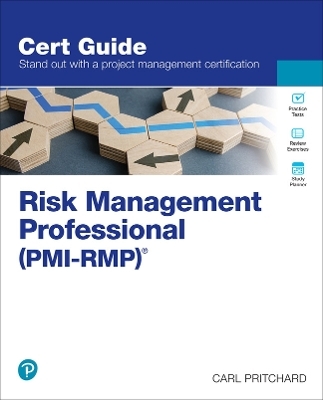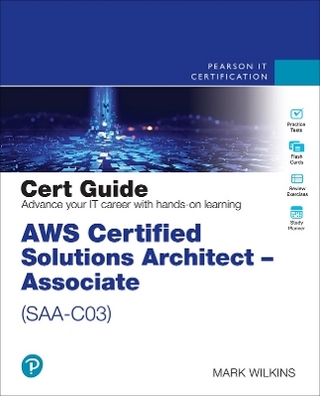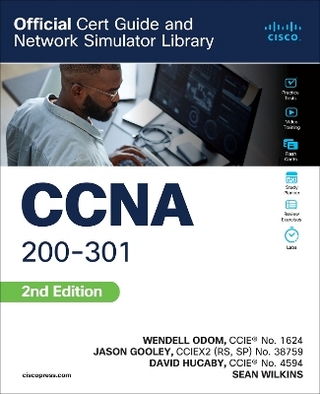
Risk Management Professional (PMI-RMP)®
Pearson IT Certification
978-0-13-810847-2 (ISBN)
Master PMI-RMP exam topics
Assess your knowledge with chapter-ending quizzes
Review key concepts with exam preparation tasks
Practice with realistic exam questions
Risk Management Professional (PMI-RMP)® Exam Cert Guide is a comprehensive exam study guide. Author and expert instructor, Carl Pritchard, shares preparation hints and test-taking tips, helping you identify areas of weakness and improve both your conceptual knowledge and hands-on skills. Material is presented in a concise manner, focusing on increasing your understanding and retention of exam topics.
The book presents you with an organized test preparation routine through the use of proven series elements and techniques. Exam topic lists make referencing easy. Chapter-ending Exam Preparation Tasks help you drill on key concepts you must know thoroughly. Review questions help you assess your knowledge, and a final preparation chapter guides you through tools and resources to help you craft your final study plan.
The companion website contains the powerful Pearson Test Prep practice test software, complete with hundreds of exam-realistic questions. The assessment engine offers you a wealth of customization options and reporting features, laying out a complete assessment of your knowledge to help you focus your study where it is needed most.
Well regarded for its level of detail, assessment features, and challenging review questions and exercises, this study guide helps you master the concepts and techniques that will enable you to succeed on the exam the first time.
This book will prepare you for the PMI-RMP® examination, enabling you to
Learn the different roles in an effective project risk management organization
Understand the different risk practices in waterfall, hybrid, and agile organizations
Grasp the distinctions between risk appetites and attitudes
Effectively identify and manage risk tolerances and triggers
Get others to participate in the risk management process appropriately
Identify risk using a variety of different tools
Create risk registers and repositories for posterity
Develop strategies and responses for both threats and opportunities
Generate risk approaches based on project assumptions
Analyze risks both qualitatively and quantitatively
Recognize when workarounds are the only possible course of action
Close out and retire risks as appropriate
Carl Pritchard, PMI-RMP, PMP is a thought leader in the risk management community, where he has been involved for 30 years. He has written eight books and led training around the globe for the Project Management Institute, as well as for private clients. In 2019, PMI global awarded him the Eric Jenett Project Management Excellence Award, citing him as the “Best of the Best” in project management. Considered the “fun guy” of project risk management, Carl is a sought-after speaker and has presented keynote addresses for major conferences and corporate all-hands meetings. Carl is honored by his long-term relationships with PMI chapters in upstate New York, Baltimore, Pittsburgh, and the greater Washington, DC area. He resides in the mountains of western Maryland with his wife, Nancy. Additional information about Carl's current activities can be found at carlpritchard.com, and you can follow Carl on Twitter @rmpprep.
Introduction xxiv
Part I: Strategic Risk and Risk Planning
Chapter 1 The Risk Structure 3
“Do I Know This Already?” Quiz 3
Foundation Topics 6
Risk Documentation Capture 6
Industry Benchmarks 6
Project Plans 7
Lessons Learned 7
Customer Agreements 8
Project Assumptions 8
The Project Charter 8
Risk Roles and Responsibilities 9
Risk Manager 9
Risk Owner 10
Risk Team 10
Project Roles 10
Risk Responsibilities 11
The Risk Archive 11
Risk Repository 11
Risk Register 11
Exam Preparation Tasks 14
Chapter 2 Risk Environment and Culture 19
“Do I Know This Already?” Quiz 20
Foundation Topics 23
Risk Attitude, Appetite, and Maturity 23
Tolerance 23
Threshold 23
Appetite 24
Attitude 25
Risk Maturity 25
Risk Assumptions 26
Constraint-Driven Risks 27
Stakeholders and Risk Culture 27
Salience Model 29
Stakeholder Tolerances 30
Risk Owners 31
Stakeholder Risk Planning 32
Program Stakeholders 33
Portfolio Stakeholders 33
Data Processing 33
Organizational Infrastructure 33
Communication 34
Facilities, Equipment, and Hardware 34
Capacity 34
Exam Preparation Tasks 35
Chapter 3 Tolerance, Thresholds, and Triggers 39
“Do I Know This Already?” Quiz 39
Foundation Topics 43
Risk Absorption 43
Organizational and Project Risk Tolerance 44
Organizational Risk Tolerance 44
Project Risk Tolerance 45
Thresholds 45
Triggers 46
Recognizing and Resolving Cultural Discord 46
Exam Preparation Tasks 48
Chapter 4 Strategic Risk 53
“Do I Know This Already?” Quiz 54
Foundation Topics 57
Risk Process Alignment 57
Risk Management Planning 57
Risk Identification 57
Risk Analysis 57
Qualitative Analysis 58
Quantitative Analysis 58
Risk Response Development 59
Risk Response Implementation and Control 59
Risk Process Tools 59
Risk Sources and Their Roles 60
Risk Alliances 61
Exam Preparation Tasks 62
Chapter 5 The Risk Management Plan (RMP) 67
“Do I Know This Already?” Quiz 68
Foundation Topics 72
The Three R's: RAM, RACI, and RBS 72
Responsibility Assignment Matrix (RAM) 72
RACI (Responsible Accountable Consult Inform) Chart 73
The Risk Breakdown Structure 74
Risk Responsibility and Accountability 75
Risk Responsibility in the Risk Management Plan 75
Risk Accountability in the Risk Management Plan 76
Risk Communication Documentation 77
The Author 78
The Timing 78
The Recipients 78
Communications Modes 79
Risk Education and Training 80
Exam Preparation Tasks 82
Chapter 6 Connecting Others in Risk 87
“Do I Know This Already?” Quiz 87
Foundation Topics 91
Stakeholders and Their Roles 91
Strategic Risk and the Stakeholders 92
Team Engagement in Appetites, Attitudes, and Priorities 93
Forming 93
Storming 93
Norming 93
Performing 94
Adjourning 94
Team-Driven Data-Gathering Techniques 94
Brainstorming 94
Nominal Group Technique 95
Focus Groups 95
Interviews 96
The Delphi Technique 96
Meetings 96
Rules of Engagement 98
Tolerance Rules 98
Trigger Rules 99
Escalation Rules 99
Reporting Rules 100
Information–Sharing Rules 100
Risk Education Beyond the Strategic 100
Exam Preparation Tasks 101
Part II: Risk Identification
Chapter 7 Practical, Team-Based Risk Identification 107
“Do I Know This Already?” Quiz 108
Foundation Topics 111
Identification Approaches 111
Mind Mapping 111
Affinity Diagram 112
Root Cause Analysis 113
Checklist Analysis 115
Assumptions Analysis 115
SWOT Analysis 116
Expert Judgment 117
The Risk Questions 117
Preliminary Data Analysis 118
The Risk Register 119
Exam Preparation Tasks 120
Chapter 8 Constraints and Assumptions 125
“Do I Know This Already?” Quiz 125
Foundation Topics 129
Constraints as Risk Drivers 129
Known-Knowns 129
Unknown-Knowns 130
Unknown-Unknowns 130
Known-Unknowns 131
Pure Versus Business or Speculative Risk 131
Changes in Constraints 131
Assumptions as Identified Risks 132
The Open Assumptions and Constraints Discussion 133
Assumptions, Constraints, Tolerances, and Thresholds 133
Exam Preparation Tasks 134
Chapter 9 Applying Triggers and Thresholds 139
“Do I Know This Already?” Quiz 139
Foundation Topics 143
Compliance and the Implications of Tolerance 143
Tolerance- and Threshold-Driven Triggers 144
Visible Triggers 144
Physical Triggers 144
Stakeholder-Driven Triggers 145
Exam Preparation Tasks 146
Chapter 10 The Risk Register 151
“Do I Know This Already?” Quiz 151
Foundation Topics 155
Register Functionality 155
Register Categories 156
Risk ID 157
Risk Event 157
Probability 157
Impact 158
Urgency 158
Propinquity 158
Proximity 159
Dormancy 159
Manageability and Controllability 159
Connectivity 159
Detectability (FMEA) 160
Strategic Impact 160
Overall Risk 160
Priority 161
Risk Owner 161
Area(s) Impacted 161
Escalation 161
Response Strategy Type 162
Response Strategy Narrative Description 163
Implementation Schedule 163
Implementation Review 163
Retirement Criteria 163
Follow-up 164
Outcome 164
Archival Location 164
Risk Classification 164
Exam Preparation Tasks 165
Part III: Risk Analytics
Chapter 11 Risk Qualification 171
“Do I Know This Already?” Quiz 172
Foundation Topics 176
Risk Sorting 176
Taxonomic Review 176
Risk Management Plan Application 177
Risk Ranking 181
Group Risk Ranking 181
Individual Risk Ranking 181
Fist to Five 182
Dot Voting 182
Roman Voting 183
Consensus 183
Nominal Group Technique 183
Stakeholder-Based Ranking Support 184
Exam Preparation Tasks 184
Chapter 12 Risk Quantification 191
“Do I Know This Already?” Quiz 192
Foundation Topics 197
Performance Data and Its Implications 197
Waterfall Performance Data 197
Budget at Completion 198
Planned Value 198
Earned Value 198
Actual Costs 199
Schedule Variance and Schedule Performance Index 199
Cost Variance and Cost Performance Index 199
Estimate at Completion 200
To-Complete Performance Index 201
Agile Performance Data 201
Sprint Completion 201
User Stories Completion 202
Story Point Completion 203
General Versus Detailed Quantitative Analysis 203
General Analysis 204
Detailed Analysis 209
Sensitivity Analysis Tools 210
Monte Carlo Sensitivity Analysis 210
Tornado Diagram 211
Network Diagram Sensitivity Analysis (Critical Path) 211
Ishikawa Diagram Analysis (Root Cause) 212
Decision Tree Analysis 212
Relative Risk Weight and Priority 214
Exam Preparation Tasks 214
Chapter 13 Risk Complexity, Assessment, and Analysis 221
“Do I Know This Already?” Quiz 221
Foundation Topics 226
Risk Complexity 226
Root Cause Analysis (Ishikawa) 226
SWOT Analysis 226
Tree Diagrams 227
Fault Trees 228
Decision Trees 229
Risk Interconnectedness 231
Risk at the Organizational Level 232
Threat Versus Opportunity 233
Exam Preparation Tasks 234
Part IV: Risk Management and Resolution
Chapter 14 Response Planning 239
“Do I Know This Already?” Quiz 240
Foundation Topics 244
Opportunity Versus Threat Strategies 244
Opportunity Strategies 244
Passive Acceptance 244
Active Acceptance 245
Exploitation 245
Enhancement 245
Sharing 246
Escalation 246
Threat Strategies 246
Avoidance 247
Mitigation 248
Transfer 248
Escalation 249
Action Plans and Risk Owners 249
Action Plans 249
Agile Action Plans 250
Predictive Action Plans 250
Risk Owners 250
Resolution Metrics and Communication 251
Resolution Metrics and Evaluation 251
Workarounds 253
Response Communication 253
Organizational Impacts 254
Tolerances 254
Policy 254
Compliance 254
Objectives 255
Exam Preparation Tasks 255
Chapter 15 Response Implementation 261
“Do I Know This Already?” Quiz 262
Foundation Topics 266
Response Plans Versus Contingencies 266
Stakeholder Response Reactions 267
Nature of the Response 267
Personal/Professional Implementation Involvement 268
Personal/Professional Tolerances 269
Residual Risk and Its Implications 270
Secondary Risk and Its Implications 270
Exam Preparation Tasks 271
Part V: Tracking and Closing Out Risks
Chapter 16 Data Collection 277
“Do I Know This Already?” Quiz 277
Foundation Topics 282
Gathering Information 282
Data Sources 282
Degrees of Accuracy 283
Ranking Approach Efficacy 284
High-Probability Risk Realization 284
High-Impact Risk Realization 285
Resilience 286
Anti-fragility 286
Overall Risk and Project Influence 286
Contrasting Project and Organizational Risk 288
Project Risks in an Organizational Context 289
Organizational Risk Taking in a Project Context 289
Organizational Aspects as Risk Sources/Drivers 290
Rewards in Risk–Reward 290
Rewards to Offset Risks 291
Exam Preparation Tasks 292
Chapter 17 The Leftovers and the Latecomers 299
“Do I Know This Already?” Quiz 300
Foundation Topics 305
Residuals and Deductibles 305
Deployed and Undeployed Responses 305
Intended and Unintended Outcomes 306
Residual Project and Organizational Risk 306
Residual Financial Risk 307
Residual Quality Risk 307
Residual Reputational Risk 307
Response-Generated Risks 308
Risk Environment and Response-Generated Risk 308
Specific Responses That Generate Risk 309
Firm-Fixed Price Contracts 309
Fixed-Price Economic Adjustment (FPEA) Contracts 309
Fixed-Price Incentive Fee (FPI or FPIF) Contracts 310
Cost-Plus Incentive Fee (CPIF) Contracts 310
Cost-Plus Award Fee (CPAF) Contracts 311
Cost-Plus Fixed Fee (CPFF) Contracts 311
Time and Materials (T&M) Contracts 311
Cost-Plus Percentage of Cost (CPPC) Contracts 312
Contract Type Summary 312
Late Risk Reporting 314
Risk Register Updates 314
Workaround Reporting 316
Exam Preparation Tasks 317
Chapter 18 Sharing Risk Information 323
“Do I Know This Already?” Quiz 324
Foundation Topics 329
Risk Reporting 329
Qualitative Data Gathering and Reporting: Predictive 329
Qualitative Data Gathering and Reporting: Adaptive 330
Quantitative Data Gathering and Reporting: Predictive 330
Quantitative Data Gathering and Reporting: Adaptive 331
Related Document Updates 332
Management Plan Updates 332
Lessons Learned Updates 333
Change Log Updates 333
Project-wide Risk Updates 334
How Has the Project Gone? 334
What Risks Remain? 334
What's the Likelihood of Success? 335
Organization-wide Risk Updates 336
Organizational Impact Risks 336
Personnel/Stakeholders Risk Updates 336
Deliverables Organizational Risks (Quality) 337
System Life Cycle Risk Updates 337
Unanticipated Overuse 338
Environmental/Technical/Organizational Change 338
Updated Risks to the Project Management Culture 340
Cultural “Get Away with It” Risk Updates 340
Misapplication Risk Updates 340
Tolerance Updates 341
Exam Preparation Tasks 341
Part VI: Final Preparation
Chapter 19 Final Preparation 347
Suggested Plan for Final Review and Study 347
Summary 348
Appendix A Answers to the “Do I Know This Already?” Quizzes and Review Questions 349
Appendix B PMI-RMP (Risk Management Professional) Cert Guide Exam Updates 377
Glossary of Key Terms 379
ONLINE ELEMENTS
APPENDIX C Study Planner
Glossary of Key Terms
9780138108472 TOC 3/7/2023
| Erscheint lt. Verlag | 7.4.2024 |
|---|---|
| Reihe/Serie | Certification Guide |
| Verlagsort | Upper Saddle River |
| Sprache | englisch |
| Maße | 78 x 94 mm |
| Gewicht | 840 g |
| Themenwelt | Informatik ► Weitere Themen ► Zertifizierung |
| ISBN-10 | 0-13-810847-1 / 0138108471 |
| ISBN-13 | 978-0-13-810847-2 / 9780138108472 |
| Zustand | Neuware |
| Haben Sie eine Frage zum Produkt? |
aus dem Bereich


